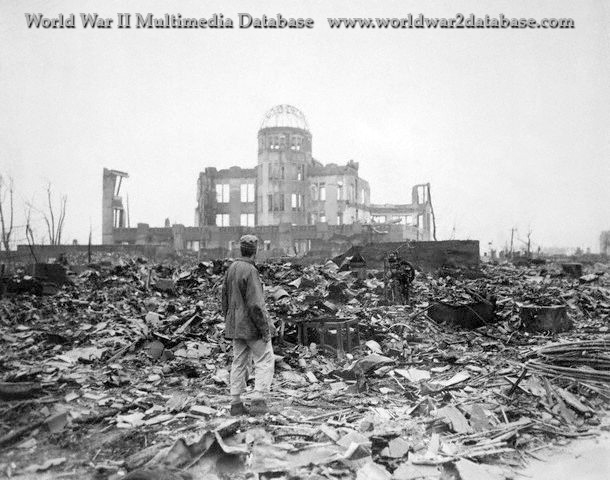| American Survey Team Member pauses in front of the Hiroshima Prefectural Industrial Promotion Hall. The 4 square miles of densely built-up area in the heart of the city — residential, commercial, and military — contained three-fifths of the total population. If there were about 245,000 people in the city at the time of the attack, the density in the congested area must have been about 35,000 per square mile. Five completed evacuation programs and a sixth then in progress had reduced the population from its wartime peak of 380,000. In Hiroshima the dwellings were of wood construction; very few were more than two stories. There were no masonry division walls. Large groups of dwellings clustered together. The type of construction, coupled with antiquated fire-fighting equipment and inadequately trained personnel, made even in peacetime a high possibility of conflagration. Nearly seven percent of the residential units had been torn down to make firebreaks, but the firestorm jumped the human-made breaks and the rivers as well. Many buildings were of poor construction by American standards. The principal points of weakness were the extremely small tenons, the inadequate tension joints, and the inadequate or poorly designed lateral bracings. Reinforced concrete framed buildings were not uniform in design and in quality of materials. Some of the construction details (reinforcing rod splices, for example) were often poor, and much of the concrete was definitely weak; thus some reinforced concrete buildings collapsed and suffered structural damage when within 2,000 feet of the hypocenter, and some internal wall paneling was demolished even up to 3,800 feet. Other buildings, however, were constructed far more strongly than is required by normal building codes in America, to resist earthquakes. Since the 1923 earthquake, construction regulations in Japan have specified that the roof must safely carry a minimum load of 70 pounds per square foot (708 kilograms per square centimeter) whereas American 1945 requirements did not normally exceed 40 pounds per square foot (405 kilograms per square centimeter) for similar types. Though the regulation was not always followed, this extra strong construction was encountered in some of the buildings near ground zero at Hiroshima, and undoubtedly accounts for their ability to withstand atomic bomb pressures without structural failures. | |
| Image Filename | wwii1091.jpg |
| Image Size | 149.66 KB |
| Image Dimensions | 610 x 480 |
| Photographer | Troutman, Stanley |
| Photographer Title | |
| Caption Author | Jason McDonald |
| Date Photographed | September 07, 1945 |
| Location | Hiroshima Prefectural Industrial Promotion Hall, the “Atomic Bomb Dome“ |
| City | Hiroshima |
| State or Province | Hiroshima Prefecture |
| Country | Japan |
| Archive | |
| Record Number | |
| Status | Caption ©2007, ©2024 MFA Productions LLC Please Do Not Duplicate or Distribute Without Permission |

Author of the World War II Multimedia Database

